#solar pond pumps
Explore tagged Tumblr posts
Text
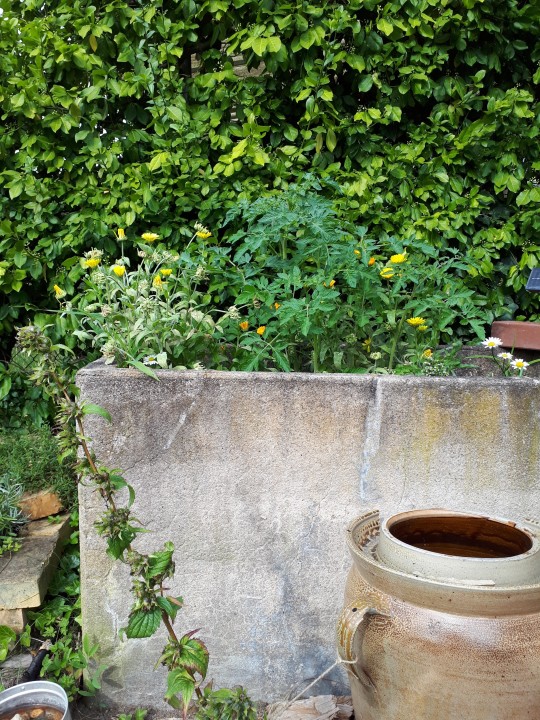

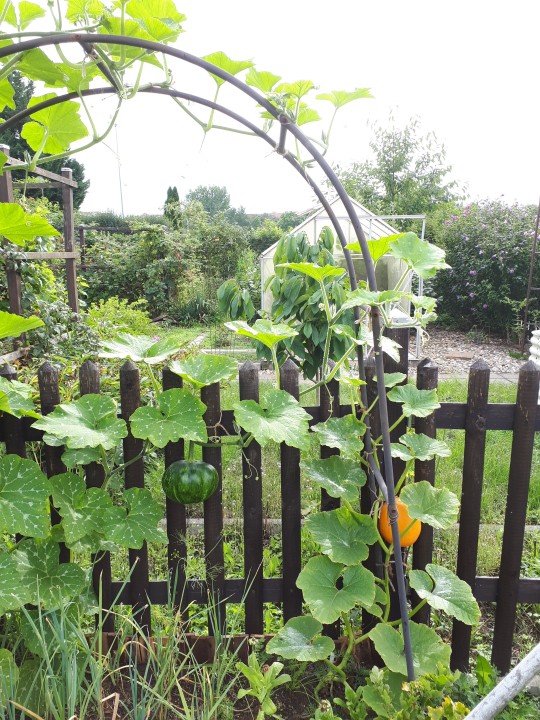
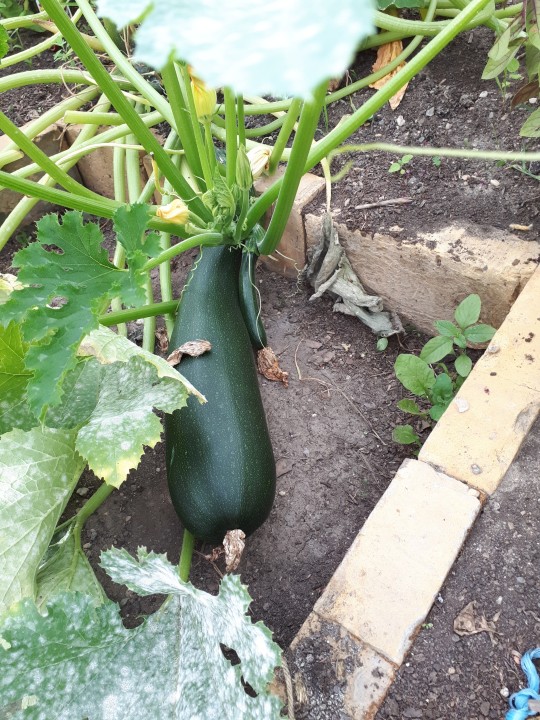
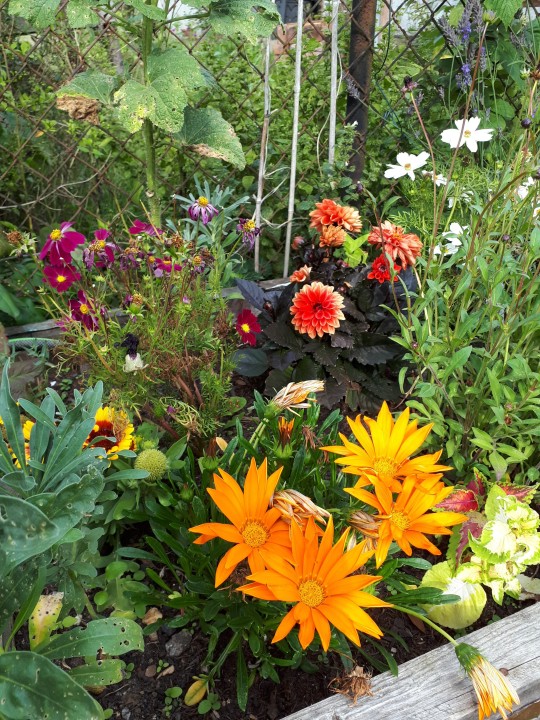
Habemus pumpkin :D two of them worked out and are making beautiful fruit. Forgot again to harvest the courgette so we'll have to find a good use for that much zucchini meat 😅
#the sunflowers bring me such joy#how can a flower grow that massive#they have tree trunks!#i started the new water feature - an old kettle i got from ebay#i hope the solar-powered pump will do better there than in our muddy house pond#couldn't work too much though - only water some things#since my hands are still starting to tingle every time i grab something#garden blogging
5 notes
·
View notes
Text
Harness Solar Energy with Water Pumps for Ponds & Wells
Solar water pumps harness renewable energy to efficiently power water systems for wells, ponds, and irrigation. They provide a sustainable, cost-effective alternative to traditional pumps, ideal for remote areas or eco-conscious users. From solar well pumps to pond pumps, these systems offer reliable performance, reducing energy costs and environmental impact while ensuring a consistent water supply.
For More
0 notes
Text
Oxygenation and Aeration for Koi Ponds: A Complete Guide
Learn how to improve oxygenation and aeration for koi ponds. Discover effective methods such as waterfalls, air pumps, aquatic plants, and solar aerators to keep your koi pond oxygen-rich and healthy.
Koi ponds are more than just a visual centerpiece—they are a living ecosystem that requires careful balance to keep your koi healthy and thriving. One of the most crucial factors in maintaining that balance is ensuring proper oxygen levels in the water. Without sufficient oxygen, koi can become stressed, leading to health issues and even fatalities. That’s why oxygenation and aeration for koi…
#air pumps for koi ponds#aquatic plants for oxygen#koi pond aeration#koi pond care#maintaining oxygen levels#oxygenation for ponds#pond waterfalls#solar aerators#water quality for koi
0 notes
Text
Efficient Water Solutions: Harness the Power of Solar Well Pumps

These innovative pumps harness solar energy to provide a reliable and eco-friendly way to access water, making them ideal for both agricultural and residential use. By using solar power, Solar Well Pumps significantly reduce electricity costs and promote sustainability. They are especially beneficial in remote areas where traditional power sources are not readily available. Embrace the benefits of clean, renewable energy for your water needs and contribute to a greener planet with solar well pumps.
For More:
#solar water pump#deep well pump#solar water pumps#motar#solar powered water pump#solar well pump#solar pond aerator#solar powered well pump#solar pump#dc solar
0 notes
Text
Choose online efficient Eco Solar Pond Pumps. Save energy & costs with sustainable solutions. Ideal for eco-friendly pond maintenance.
0 notes
Text
Things to Do that Aren't Related to Growing Plants
This is my second post in a series I’ll be making on how to increase biodiversity on a budget! I’m not an expert--just an enthusiast--but I hope something you find here helps!
Some of us just don’t have much luck when it comes to growing plants. Some of us simply want to aim for other ways to help that don’t involve putting on gardening gloves. Maybe you've already got a garden, but you want to do more. No problem! There’s a couple of options you can look into that’ll help attract wildlife in your area without even having to bring out any shovels!
Provide a Water Source
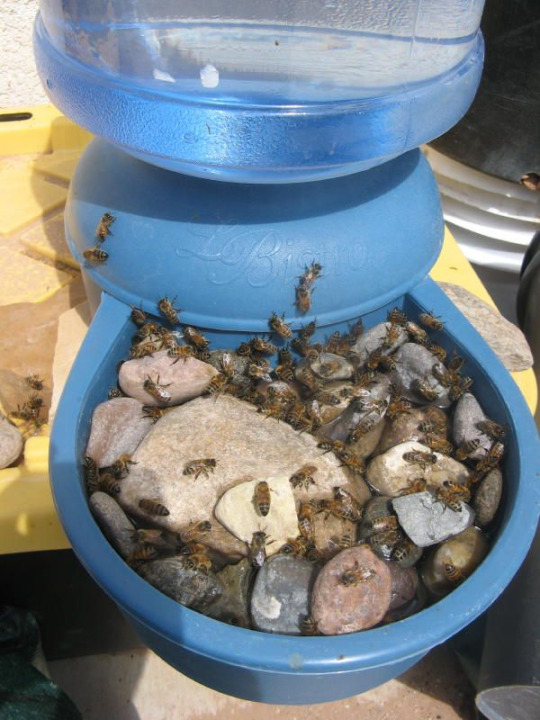
Oftentimes when I see ‘add a water source’ in informational articles about improving your backyard for wildlife, it’s almost always followed by an image of a gorgeous backyard pond with a waterfall and rock lining that looks expensive to set up, difficult to maintain, and overall just… not feasible for me. Arguably, not feasible for a lot of people. And that’s okay! There’s still ways to add water in your garden for all kinds of creatures to enjoy!
There’s tons of ways to create watering stations for insects like bees and butterflies. A self refilling dog bowl can work wonders! Add some stones into the receiving tray for insects to land on or use to climb out, and you’ve got a wonderful drinking spot for all kinds of insects! You can also fill a saucer or other dish with small stones and fill it, though it’ll likely need refilling daily or even several times a day during hot times.
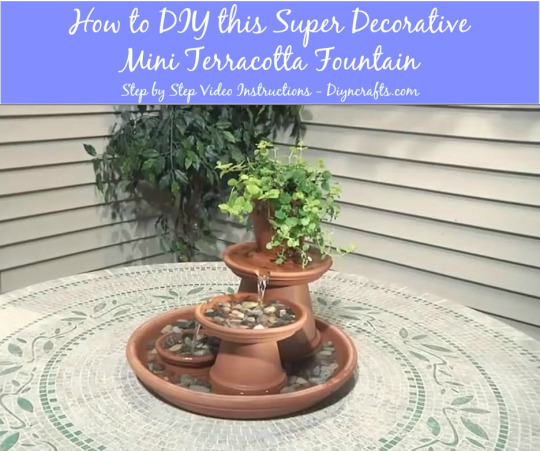
I've seen people online use all kinds of things to make water features. Some go with terra-cotta pots, pebbles, and a cheap pump to get a small and simple fountain. Others use old tires, clay, and a hole in the ground to create an in-ground mini pond system. If all else fails, even a bucket or watertight box with a few plants in it can do the trick--though do be wary of mosquitoes if the water isn’t moving. In situations like these, a solar-powered fountain pump or bubbler are great for keeping the water moving while still making it a drinking option for wildlife (it not even more appealing for some)--and these items can be obtained fairly cheap online!
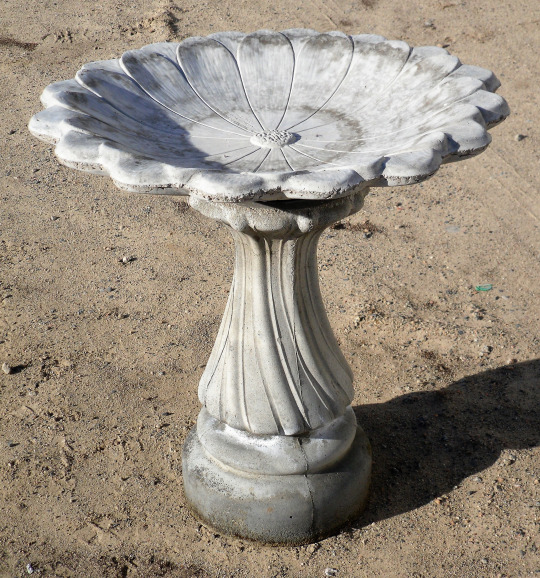
Bird baths are an option as well--a classic way to provide for birds in your area, they can be easy to find online or in a gardening store! The only downside is that a good, quality bird bath can be pricey up-front. However, a nice stone bird bath should last a long time, be easy to clean and refill, and be enjoyed by many birds! I’ve also seen tutorials on how to make your own with quickcrete! Bird baths will be a welcome sight to birds, as they provide a space for them to drink and bathe to regulate the oils in their feathers for flight and insulation. Putting a stone in the middle will also help insects to escape if they fall in, and provide a place to perch so they can get their own drink. You’ll want to change the water and clean the baths regularly--as often as once a week, if you can manage it.
If possible, it’s highly encouraged to fill and refill water features with rainwater instead of tap water. Tap water is often treated, so instead of using hoses or indoor kitchen water, collecting some rainwater is a great alternative. Collecting rainwater can be as simple as leaving cups, bins, or pots outside for awhile.
Butterflies and other creatures will also drink from mud puddles. If you can maintain an area of damp soil mixed with a small amount of salt or wood ash, this can be fantastic for them! Some plants also excel at storing water within their leaves and flowers (bromeliads come to mind), making them an excellent habitat for amphibians as well as a drinking spot for insects and birds.
Bird Feeders and Bird Houses
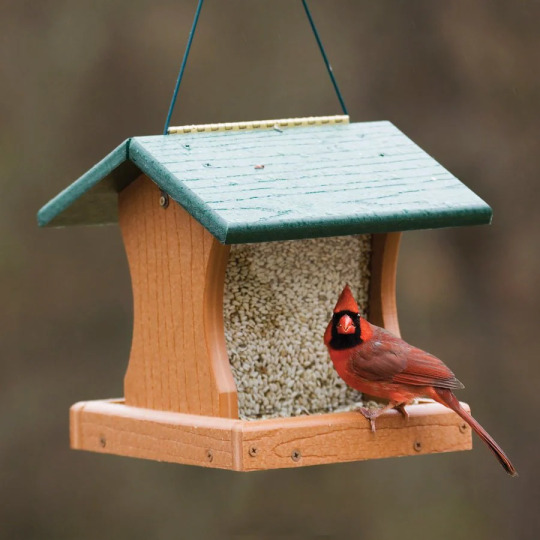
Some of the fancy, decorated bird feeders are expensive, but others can be pretty low-cost--I got my bird feeder from Lowe’s for around 10 dollars, and a big bag of birdseed was around another 10 dollars and has lasted several refills! If you don’t mind occasionally buying more birdseed, a single birdfeeder can do a lot to attract and support local birds! If you’re handy, have some spare wood, and have or can borrow some tools, you may even be able to find instructions online to make your own feeder. You may not even need wood to do so! Even hummingbird feeders, I’ve found, are quick to attract them, as long as you keep them stocked up on fresh sugar water in the spring and summer!
An important note with bird feeders is that you have to make sure you can clean them regularly. Otherwise, they may become a vector for disease, and we want to avoid causing harm whenever possible. Also keep an ear out and track if there’s known outbreaks of bird diseases in your area. If local birding societies and scientists are advising you take your birdfeeders down for awhile, by all means, do it!
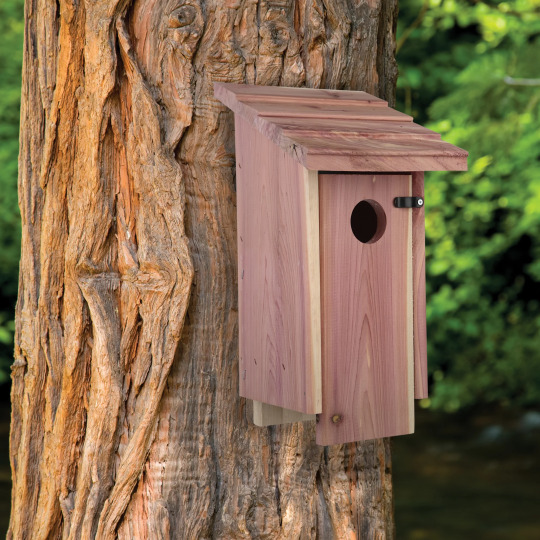
Bird houses are naturally paired with bird feeders as biodiversity promoters for backyard spaces, and it makes sense. Having bird houses suited to birds in your area promotes them to breed, raise their young, disperse seeds, and generally engage in your surrounding environment. Setting them up takes careful selection or construction, preparation, and some patience, but sooner or later you might get some little homemakers! Keep in mind, you will need to clean your birdhouses at least once a year (if not once per brood) to make sure they’re ready and safe for birds year after year--you wouldn’t want to promote disease and parasites, after all. But they could be a valuable option for your landscape, whether you purchase one or construct your own!
Again, do make sure you're putting up the right kind of boxes for the right kinds of birds. Bluebird boxes are some I see sold most commonly, but in my area I believe they're not even all that common--a nesting box for cardinals or chickadees would be far more likely to see success here! And some birds don't even nest in boxes--robins and some other birds are more likely to use a nesting shelf, instead! Research what birds live in your area, take note of any you see around already, and pick a few target species to make homes for!
Solitary Bee Houses
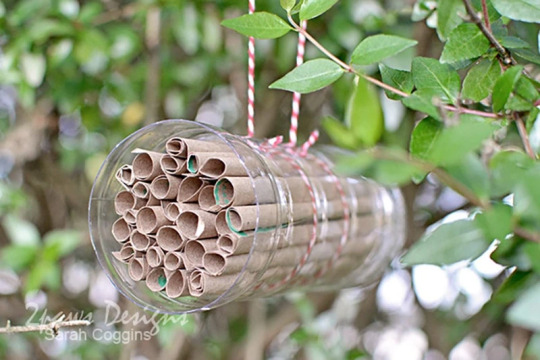
A bee house or bee hotel is a fantastic way to support the solitary bees in your area! For a few dollars and some annual cleaning, you can buy a solitary bee house from most big box nurseries. Alternatively, you can make one at home, with an array of materials you may already have lying around! You can even make them so that they’ll benefit all kinds of insects, and not necessarily just bees.
Though you don’t even necessarily have to break out the hammer and nails, buy a ton of bricks, or borrow a staple gun. Making homes for tunneling bees can be as simple as drilling holes in a log and erecting it, or drilling holes in stumps and dead trees on your property. You might even attract some woodpeckers by doing this!
Providing Nesting Area
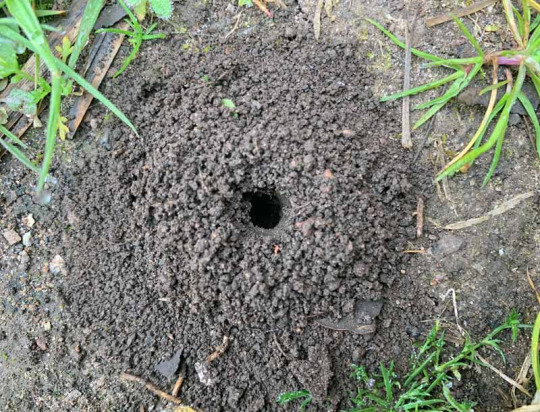
There are tons of different kinds of bees, and they all make different kinds of homes for themselves. Not all of them make big cavity hives like honey bees, or will utilize a solitary bee house. Bumblebees live in social hives underground, particularly in abandoned holes made by rodents--some others nest in abandoned bird nests, or cavities like hollow logs, spaces between rocks, compost piles, or unoccupied birdhouses. Borer, Ground, and Miner bees dig into bare, dry soil to create their nests. Sparsely-vegetated patches of soil in well-drained areas are great places to find them making their nests, so providing a similar habitat somewhere in the garden can encourage them to come! I do talk later in this document about mulching bare soil in a garden--however, leaving soil in sunny areas and south-facing slopes bare provides optimal ground nesting habitat. Some species prefer to nest at the base of plants, or loose sandy soil, or smooth-packed and flat bare ground. They’ve also been known to take advantage of soil piles, knocked over tree roots, wheel ruts in farm roads, baseball diamonds and golf course sand traps. You can create nesting ground by digging ditches or creating nesting mounds in well-drained, open, sunny areas with sandy or silty soil. However, artificially constructed ground nests may only have limited success.
Providing Alternative Pollinator Foods
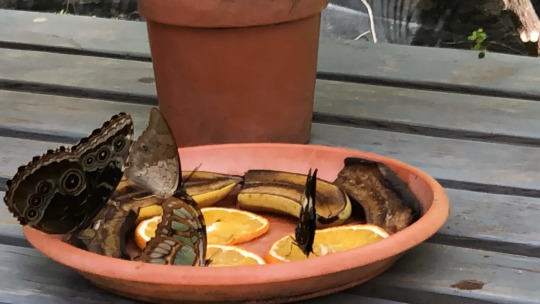
Nectar and pollen aren’t the only foods sought out by some pollinators! Some species of butterflies are known to flock to overripe fruit or honey water, so setting these out can be an excellent way to provide food to wildlife. You may want to be cautious about how you set these out, otherwise it can help other wildlife, like ants or raccoons. Butterflies may also drop by to visit a sponge in a dish of lightly salted water.
Bat Houses and Boxes
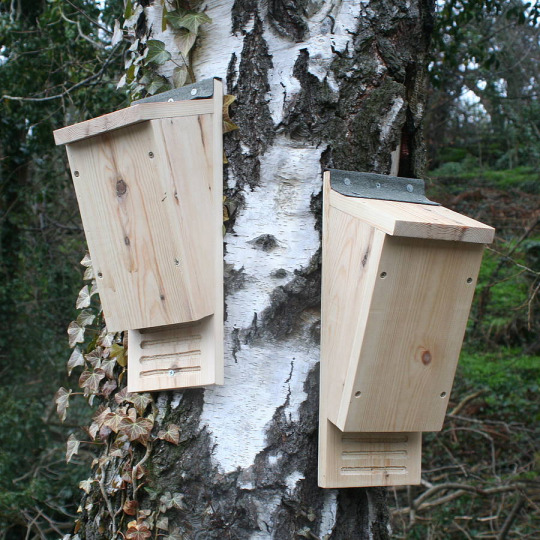
Big or small, whether they support five bats or five hundred, making bat boxes and supporting local bats is a great way to boost biodiversity! Not only will they eat mosquitoes and other pest species, but you may also be able to use the guano (bat droppings) as fertilizer! Do be careful if you choose to do that though--I’ve never had the opportunity to, so do some research into how strong it is and use it accordingly.
Provide Passageway Points
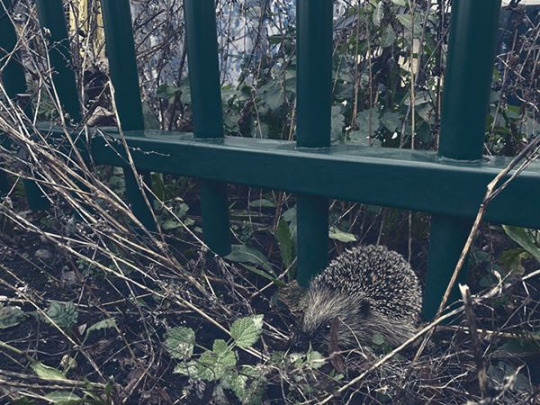
If you want your area to be more accessible for creatures that can’t fly or climb fences, allowing or creating access points can be an excellent way to give them a way in and out. Holes in the bottom of walls or fences can be sheltered with plants to allow animals through.
In a somewhat similar manner, if you’re adding a water fixture, it’s important to provide animals a way to get into and out of the pond--no way in, and they can’t use the water. No way out, and they may drown. Creating a naturalistic ramp out of wood beams or sticks, or stepped platforms out of bricks, stones, or logs can do the trick.
Get or Keep Logs and Brush Piles

I’ve already mentioned logs a good handful of times so far in this post. To be used as access ramps, or as nesting areas for solitary bees. But they have value as much more than that! Logs on the ground provide shelter for all kinds of animals, especially depending on size--anything from mice, reptiles, and amphibians to things like turkey vultures and bears will use fallen logs as shelter. Inside of a decaying log, there’s a lot of humidity, so amphibians are big fans of them--meanwhile, the upper sides of them can be used as sunning platforms by things like lizards. Other animals can also use the insides of logs as nest sites and hiding places from predators too big to fit inside. Fungi, spiders, beetles, termites, ants, grubs, worms, snails, slugs, and likely much more can be found inside rotting logs, using the rotting wood as food sources or nesting places. They can then provide food for mammals, amphibians, reptiles, and birds. They can also be regarded as a landmark or territory marker as wildlife get more familiar with your space.
So how do you get logs for cheap? Try Chip Drop! I talk about them more in a future post, but you can mark saying that you’d like logs in your drop, so they’ll give you any they have! In fact, you may even get a drop faster if you're willing to accept some logs. You may also be able to approach arborists you see working in your area and ask for logs. There may also be local online listings for people selling logs for cheap, or just trying to get rid of them. If there’s land development going on near you, you may be able to snag logs from trees they cut down to make space. Do keep in mind, you don’t need to have huge gigantic logs laying around your property to make an impact--even small logs can help a lot.
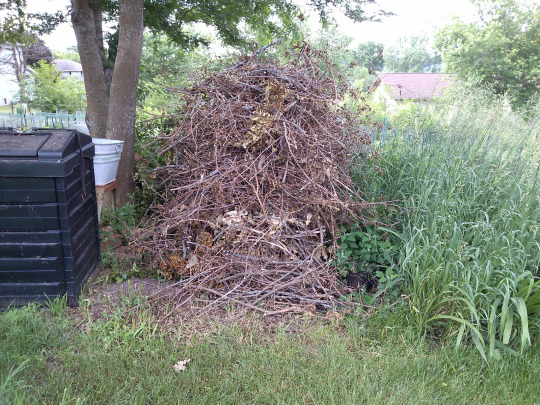
If possible, creating and leaving brush piles on the edge of your property can be a great boost to biodiversity--even if you may not see the wildlife using it. They’ll provide shelter from weather and predators, and lower portions are cool and shady for creatures to avoid the hot sun. The upper layers can be used as perch sites and nest sites for song birds, while lower layers are resting sites for amphibians and reptiles, and escape sites for many mammals. As the material decays, they also attract insects, and as such they’ll attract insect-eating animals too. As more small animals find refuse in your brush pile, their predators will be attracted to them as well. Owls, hawks, foxes, and coyotes are known to visit brush piles to hunt. Making a brush pile can be as simple as piling branches and leaves into a mound, as big or as small as you want. You can even use tree stumps or old fence posts near the base, and keep stacking on plant trimmings and fallen branches. Do note that you don’t want to do this near anything like a fire pit.
Don't forget, with all of these, your mileage may vary for any variation of reasons, so don't worry if you can't take all of even any of these actions! Even just talking about them with other people may inspire someone else to put out a bat box, or leave a few logs out for wildlife!
That's the end of this post! My next post is gonna be about ways to get seeds and plants as cheaply as possible. For now, I hope this advice helps! Feel free to reply with any questions, success stories, or anything you think I may have forgotten to add in!
#biodiversity#solarpunk#environmental stewardship#gardening#outdoor gardening#(i know this is literally the Dont Gotta Garden post but these could also be excellent additions to a preexisting garden so)#ani rambles#out of queue#the biodiversity saga#here in the tags to once again emphasize your mileage may vary with all of these#my mom is scared of bats theres no way in hell shes gonna let me put up a bat box#but I have been able to put out a shallow bird bath and a little solarpowered hummingbird bath fountain#do what you can! every bit counts! You may be able to do something that I or your neighbors can't!#for example my nextdoor neighbors have literally no trees in their backyard where the hell would they put a bat box#meanwhile i have trees in my backyard but still can't put up a bat box. maybe the neighbors next to me could!#similarly brush piles are a no go for my family but someone somewhere else could set one up!#i am rambling in the tags now uh long story short do what you can don't stress about what you can't
4K notes
·
View notes
Text
Like. Fucking. Hell. Electricity can be a legitimately useful resource but we For Real do not need this much of it
There are so many ways of producing electricity that are dependent on like either damage that has already been done (hey fun fact didja know solar fields decommission panels after a certain number of years? they hit like 80-90% of their original efficency and get rotated out even tho they're still very much capable of working fine!) or are just actually pretty reasonable at SMALL scales (hydro with a little water wheel from a small pond on a big creek -> can even increase biodiversity so long as ur like, paying attention and not fucking migrations with how you build things, diverting small amounts of flow from an already downhill stream for a few dozen yards can be basically fine, there's also gravity pumps uphill catchment tiny water towers etc; these systems just work with magnets and rotation, it's municipal generation and larger scale dams that get Bad)
None Of These will power millions of peoples home microwaves and electric kettles and cars and lighting and industry and all that bullshit. But there's many many years worth of reclaiming all the toxic extracted shit to power like, medical equipment. Eventually these things will fall off too, break for the last time and not be able to be fixed generations from now, but that's a lot fucking better bet for ur gr8 gr8 grandkids than no complex life on earth!
Do not fall for the trap of collapsing imperial core luxury into needs. It's unhelpful and makes you look like a callous, whiny fool. Differentiate what you need from what youve become accustomed to demanding. The world is fucking chockablock with materials that shouldn't have been made in the first place but fucking exist now, we cant compost trillions of miles of copper power lines. Municipal scales kill. Your toaster oven is not a ventilator.
139 notes
·
View notes
Text
I impulse bought some stuff I wanna use to make a lil widlife pond/small fountain kinda deal and on the one hand I wanna save the actual building of it till Solarpunk Aesthetic Week so I’ve got something I can say I’m doing/am working on but on the OTHER hand I wanna do it RIGHT NOW
Anyways here’s the stuff I got yesterday

The liatris bulbs aren’t for the pond (they were 50% off for 55 bulbs and 7ish bucks is a swanky price ngl) but I might plant them around it once I’m done.
And then I’ve also got this stuff around the house I hope to incorporate in it as well.

I’m hoping the solar pump can do the job because if not the only other pump we have on hand is electric and where I wanna put this pond isn’t very close to electricity like. At all.
24 notes
·
View notes
Text
Currently digging a terrible hole in the backyard for my micro pond. The backyard is just clay and rocks. I am using the shovel only to transport dirt. This is a pickaxe job. The pickaxe I have is only sort of attached to its handle so regularly I have to go over to an old paver and slam the head back on so that it doesn't fall off.
Hope I don't hit anything bad
And you say well why don't you call miss utility
Well I did call Miss utility but they don't know where our sewer and septic lines are because it's a private rural residence with a private septic tank
I actually do know where the septic tank is and it wouldn't really make any sense for pipes to be in the area I'm digging so I'm not actually worried lol. Plus we had a French drain dug like a foot or two away a couple years back and that goes way deeper than I'm going
How deep am I going you ask? I am not sure yet. The idea was 15 inches but 15 inches is really fucking deep in my rock hard yard. But I still have two months to take my pre-mold back and replace it with the shallower one if need be. Though I suppose if I can get 13 or 14 in I can build up rocks around it, there's already a bunch of mulch.
Now you may be thinking but why am I putting a 20 gallon pond in the ground when a micropond can just be elevated and then you don't have to worry about all of the other problems? Well, It's because I'm setting it in my herb spiral and I'm hoping to get some frogs visiting and also it's a cool aesthetic. Will be putting hornwort and maybe some water hyacinth in and if I'm feeling really bold a dwarf water lily. And lots of rocks. And no fish. And at some point there may be like a little solar pump or something because I can't run a line without way more work than I'm willing to do
7 notes
·
View notes
Text
Beasts of the Murbleage update!
So for the past couple nights I just left the solar water pump in the splash pool. out of curiosity. each night it was overturned like usual. But this morning it was overturned and the entire foam ring on the bottom was removed and not in the vicinity of the pool. Also I had added several balls of Fafner’s to float in the water and the spiky blue one was missing.
I found them a little later under a tree

I don’t know. I like that our beasts are maybe enjoying the enrichment activities of the Murbleage. I would really like a night cam on our little splash pool pond.

I cleaned it and put everything back.
And I made our dirt patch bigger.

17 notes
·
View notes
Text
Update
Well, finally got back online. Here is the updates. 500' of driveway finished. Just need to get the gravel to put on it.
We have our well in, about 210'. They hao start with a 12" drill and finished with an 8" drill head. It filled to 80' so it has (roughly) 260 gallons in the well itself. I'm hooking up a 1000 gallon holding tank in the pump house, so I should have more than enough water for every day use.
I started excavating to put in a pond in the back of the property. Going to build an elevated water tank, like you use to see for old steam trains, that will run a water wheel for power to the game room/ bar next to the pond. I'll use a solar water pump to fill the tank. The pond will also be used to water my garden area and yard.
Located an old trailer (State calls it a travel trailer since it's under 400sqft. even thought is it 10' wide and can only be moved with special permits anymore). It has the original 50 amp power plug cord, running lights, tail light and a license plate light on it still. With adding a snow roof and enclosed porch, I'll have over 800 sqft for the main house. I purchased a 21kv 80amp solar power system (21kv direct solar, 15kv battery back-up) to power the home. I can also hook up a small wind turbine to it as well. While digging around I found a septic system the previous owners had put in so no cost there for me.
I have about a dozen trees I've cut down that are over 50', so will have enough rough lumber and timber frames to start most of my building. Been negotiating with a lumber yard to trade timber for some pressure treated posts.
Picked up an old Ford 8N tractor with a back blade and front bucket. Nice tractor. My neighbor watch me use it and he was surprised how I could dig in the basalt strewn land putting in my pond. He said he had to rent a bulldozer to do the same on his property because his Kobota tractor couldn't do it.
Well, that's all for the update for now.
Oh ya, I forgot, had a visit from a couple other neighbors. An old tom came to visit with 15 of his girlfriends. And 11 black tail does came by to see how the place was going.
2 notes
·
View notes
Text
Excerpt from this story from Yale Environment 360:
Can metals that naturally occur in seawater be mined, and can they be mined sustainably? A company in Oakland, California, says yes. And not only is it extracting magnesium from ocean water — and from waste brine generated by industry — it is doing it in a carbon-neutral way. Magrathea Metals has produced small amounts of magnesium in pilot projects, and with financial support from the U.S. Defense Department, it is building a larger-scale facility to produce hundreds of tons of the metal over two to four years. By 2028, it says it plans to be operating a facility that will annually produce more than 10,000 tons.
Magnesium is far lighter and stronger than steel, and it’s critical to the aircraft, automobile, steel, and defense industries, which is why the government has bankrolled the venture. Right now, China produces about 85 percent of the world’s magnesium in a dirty, carbon-intensive process. Finding a way to produce magnesium domestically using renewable energy, then, is not only an economic and environmental issue, it’s a strategic one. “With a flick of a finger, China could shut down steelmaking in the U.S. by ending the export of magnesium,” said Alex Grant, Magrathea’s CEO and an expert in the field of decarbonizing the production of metals.
“China uses a lot of coal and a lot of labor,” Grant continued. “We don’t use any coal and [use] a much lower quantity of labor.” The method is low cost in part because the company can use wind and solar energy during off-peak hours, when it is cheapest. As a result, Grant estimates their metal will cost about half that of traditional producers working with ore.
Magrathea — named after a planet in the hit novel The Hitchhiker’s Guide to the Galaxy — buys waste brines, often from desalination plants, and allows the water to evaporate, leaving behind magnesium chloride salts. Next, it passes an electrical current through the salts to separate them from the molten magnesium, which is then cast into ingots or machine components.
While humans have long coaxed minerals and chemicals from seawater — sea salt has been extracted from ocean water for millennia — researchers around the world are now broadening their scope as the demand for lithium, cobalt, and other metals used in battery technology has ramped up. Companies are scrambling to find new deposits in unlikely places, both to avoid orebody mining and to reduce pollution. The next frontier for critical minerals and chemicals appears to be salty water, or brine.
Brines come from a number of sources: much new research focuses on the potential for extracting metals from briny wastes generated by industry, including coal-fired power plants that discharge waste into tailings ponds; wastewater pumped out of oil and gas wells — called produced water; wastewater from hard-rock mining; and desalination plants.
Large-scale brine mining could have negative environmental impacts — some waste will need to be disposed of, for example. But because no large-scale operations currently exist, potential impacts are unknown. Still, the process is expected to have numerous positive effects, chief among them that it will produce valuable metals without the massive land disturbance and creation of acid-mine drainage and other pollution associated with hard-rock mining.
According to the Brine Miners, a research center at Oregon State University, there are roughly 18,000 desalination plants, globally, taking in 23 trillion gallons of ocean water a year and either forcing it through semipermeable membranes — in a process called reverse osmosis — or using other methods to separate water molecules from impurities. Every day, the plants produce more than 37 billion gallons of brine — enough to fill 50,000 Olympic-size swimming pools. That solution contains large amounts of copper, zinc, magnesium, and other valuable metals.
3 notes
·
View notes
Text
Enhance Your Garden with the Solar Fountain Floating Lotus Leaf! 🌞💦Eco-friendly solar-powered water pump for ponds, bird baths, and pools. No electricity needed—just sunlight! Perfect for outdoor decor. 🌿☀️
Homehop Store: https://bit.ly/48GX9nP
Amazon: https://amzn.to/4fq05XL
0 notes
Text
Top 5 Features to Look for When Buying Irrigation Pumps

Investing in the right irrigation pump is essential for efficient water management in agricultural, residential, or industrial settings. With numerous options available, understanding the key features to prioritize can help you make an informed decision. Whether you’re looking to purchase through irrigation supplies online Perth or at a local store, knowing what to look for ensures you choose a pump that meets your needs and provides long-lasting performance. In this blog, we’ll explore the top five features to consider when buying an irrigation pump.
1. Pump Type and Compatibility
The type of pump you choose depends on your specific water source and irrigation requirements. There are several types to consider:
Centrifugal pumps: Ideal for shallow water sources like ponds and streams.
Submersible pumps: Designed for deep wells, operating underwater.
Solar-powered pumps: Environmentally friendly options for remote areas.
Ensure the pump you select is compatible with your irrigation system and delivers the required water pressure and flow rate for your crops or garden.
2. Energy Efficiency
Energy-efficient irrigation pumps save costs in the long run while minimising environmental impact. Look for pumps with energy-saving features, such as variable-speed drives (VSD) that adjust the motor’s speed to match water demand. Modern pumps often come with energy ratings to help you compare their efficiency. Opting for an efficient model may have a higher upfront cost, but the savings on energy bills over time make it worthwhile.
3. Durability and Material Quality
An irrigation pump is a long-term investment, so durability is crucial. Pumps made from high-quality materials like stainless steel or corrosion-resistant plastics are ideal for ensuring longevity, especially in areas with hard or saline water.
Durable construction also minimises wear and tear, reducing maintenance costs. If you’re managing a farm and dealing with tight budgets, evaluating both durability and rural fencing prices can help optimise your overall expenditure on farm essentials.
4. Flow Rate and Pressure Capacity
The flow rate and pressure capacity of a pump determine its efficiency in meeting irrigation needs. Flow rate, measured in liters per minute (L/min), should match the water demand of your irrigation system.
For large farms, pumps with higher pressure capacities ensure consistent water distribution across vast areas. On the other hand, smaller gardens or drip irrigation systems may only require low-pressure pumps. Check these metrics carefully when shopping for irrigation supplies online Perth or in physical stores.
5. Ease of Installation and Maintenance
Choose an irrigation pump that is easy to install and maintain. Features like a clear user manual, modular design, and accessible components can simplify the process.
Pumps requiring frequent maintenance or repairs can lead to downtime and increased operational costs. Look for models with self-cleaning mechanisms or simple maintenance requirements to save time and effort.
Bonus Tips for Buying Irrigation Pumps
Warranty and Support: Ensure the pump comes with a reliable warranty and access to customer support.
Adaptability: Opt for pumps that can handle a range of irrigation methods, such as sprinklers, drip systems, or flood irrigation.
Portability: For smaller operations, portable pumps offer versatility and ease of use.
Selecting the right irrigation pump requires careful consideration of factors such as compatibility, efficiency, durability, and ease of maintenance. Whether you’re comparing rural fencing prices to streamline your farm setup or purchasing irrigation supplies online or locally, prioritising quality and functionality will ensure you get the best value for your investment. Start exploring your options today and make a choice that enhances your irrigation system’s performance while saving resources.
0 notes
Text
Diverse Product Portfolio
A leading water pump supplier stands out by offering a diverse product portfolio that caters to a wide range of applications across residential, commercial, and industrial sectors. This variety ensures that customers can find tailored solutions for their unique needs, backed by the latest technology and engineering excellence.

Here’s an overview of what constitutes a diverse water pump product portfolio:
1. Residential Water Pumps
Applications: Domestic water supply, garden irrigation, and boosting household water pressure.
Popular Types:
Booster Pumps: Enhance water pressure for household needs.
Submersible Pumps: Ideal for wells, tanks, and underwater applications.
Centrifugal Pumps: Common for general water transfer.
Features: Compact designs, quiet operation, and energy efficiency.
2. Commercial Water Pumps
Applications: Hotels, office buildings, retail spaces, and urban water supply systems.
Popular Types:
Inline Circulation Pumps: Used in HVAC systems for heating and cooling.
Pressure Booster Systems: Ensure steady water supply in multi-story buildings.
Drainage Pumps: Handle wastewater and stormwater management.
Features: High performance, ease of maintenance, and scalable designs.
3. Industrial Water Pumps
Applications: Manufacturing plants, mining, oil and gas, power generation, and chemical processing.
Popular Types:
Vertical Turbine Pumps: Suitable for large-scale water transfer.
Multistage Pumps: Handle high-pressure requirements in industrial processes.
Dewatering Pumps: Remove water from mines, construction sites, and flooded areas.
Features: Heavy-duty construction, corrosion resistance, and adaptability to extreme conditions.
4. Agricultural Water Pumps
Applications: Irrigation, livestock watering, and drainage in farmlands.
Popular Types:
Borewell Pumps: Extract groundwater efficiently.
Surface Pumps: Transfer water from ponds, rivers, and reservoirs.
Sprinkler Pumps: Distribute water evenly for irrigation.
Features: High efficiency, durability, and ability to handle varying water qualities.
5. Specialized Pumps for Niche Markets
Applications: Unique industries or specific operational needs.
Popular Types:
Chemical Pumps: Handle corrosive and hazardous liquids.
Food-Grade Pumps: Used in food and beverage production.
Solar-Powered Pumps: Ideal for off-grid water supply systems.
Features: Custom-built designs, compliance with industry standards, and innovative technologies.
6. Smart Pumps and IoT-Enabled Solutions
Applications: Modern facilities with a focus on efficiency and automation.
Features:
Remote monitoring and control.
Energy-saving algorithms.
Predictive maintenance features.
Benefits: Improved operational efficiency, reduced energy consumption, and enhanced reliability.
7. Renewable Energy-Powered Pumps
Applications: Sustainable water supply solutions in rural or remote areas.
Types:
Solar Water Pumps: Harness solar energy for pumping water.
Wind-Powered Pumps: Use wind energy for eco-friendly water supply.
Benefits: Reduced dependence on traditional energy sources, lower operating costs, and environmental sustainability.
8. High-Capacity Pumps for Infrastructure Projects
Applications: Municipal water supply, flood control, and large-scale irrigation.
Popular Types:
Axial Flow Pumps: Move large volumes of water at low heads.
Split-Case Pumps: Reliable for high-flow applications.
Features: Robust designs, low maintenance, and long service life.
9. Wastewater and Sewage Pumps
Applications: Wastewater treatment plants, sewage systems, and industrial wastewater management.
Popular Types:
Submersible Sewage Pumps: Handle solid-laden wastewater efficiently.
Sludge Pumps: Designed for thick and viscous sludge.
Features: Anti-clogging designs, corrosion resistance, and high-capacity handling.
10. Accessories and Spare Parts
Range Includes:
Pump controllers.
Pressure vessels.
Seals, bearings, and impellers.
Benefits: Ensures the longevity and efficient operation of pump systems.
Benefits of a Diverse Product Portfolio
Comprehensive Solutions: Meet varied customer needs across different sectors.
Enhanced Efficiency: Access to specialized pumps for specific applications ensures optimal performance.
Cost-Effectiveness: A wide range of options allows customers to choose products that fit their budgets and requirements.
Future-Ready: Availability of smart and renewable-powered pumps positions the supplier as a leader in innovation.
A diverse product portfolio is a hallmark of a leading water pump supplier. By offering solutions for residential, commercial, industrial, and specialized applications, these suppliers cater to a wide array of customer needs. Their ability to integrate advanced technologies, sustainability, and customization ensures they remain at the forefront of the industry. For more info contact Water Pump Suppliers in UAE or call us at +971 4 2522966.
0 notes
Text
Harness Solar Energy with Water Pumps for Ponds & Wells

Solar water pumps harness renewable energy to efficiently power water systems for wells, ponds, and irrigation. They provide a sustainable, cost-effective alternative to traditional pumps, ideal for remote areas or eco-conscious users. From solar well pumps to pond pumps, these systems offer reliable performance, reducing energy costs and environmental impact while ensuring a consistent water supply.
For More:
#solar water pump#solar water pumps#solar pump#solar pumps#solar well pump#solar powered water pump#solar powered well pump#solar powered pump#solar powered water pumps#solar water pumping
0 notes